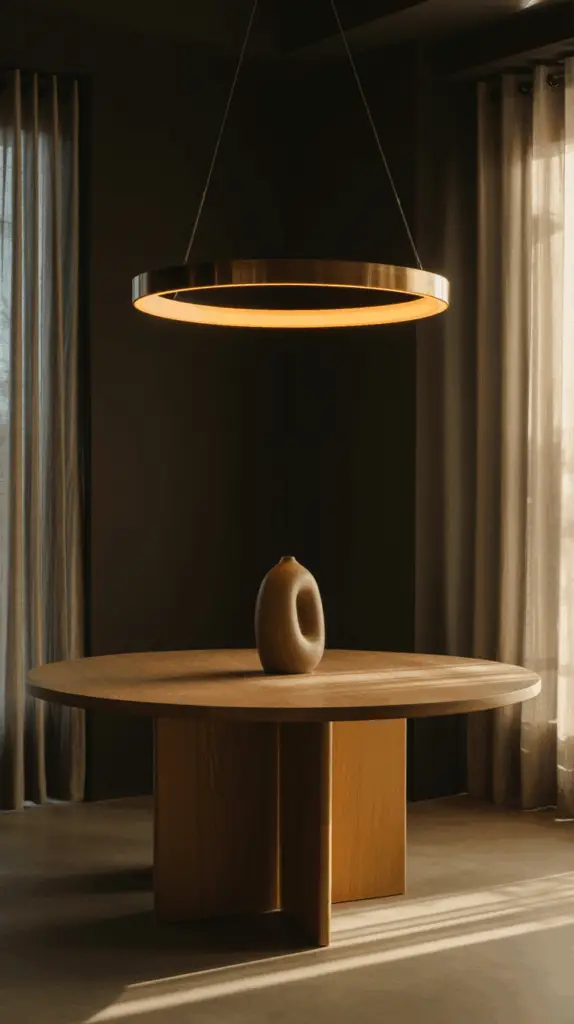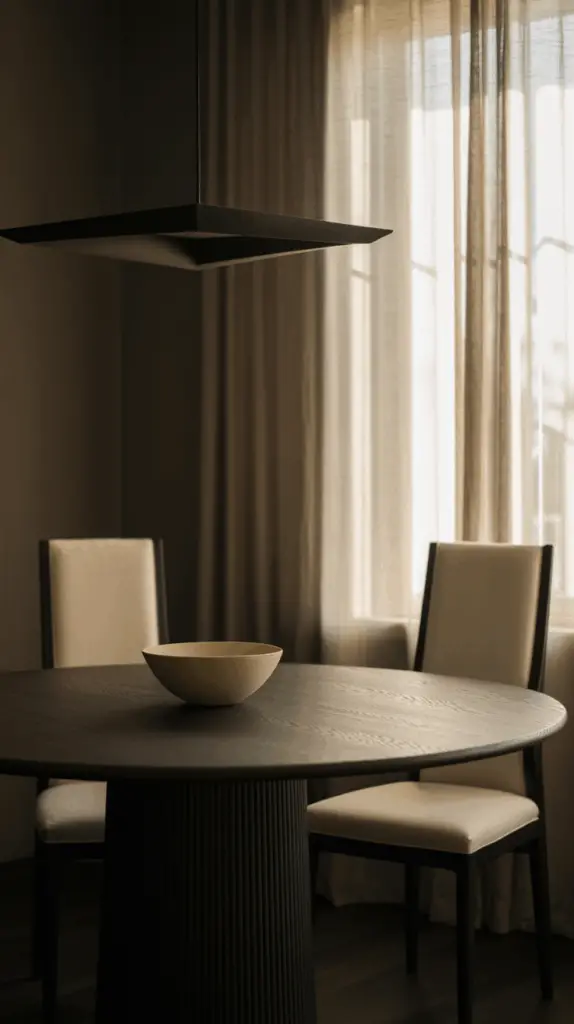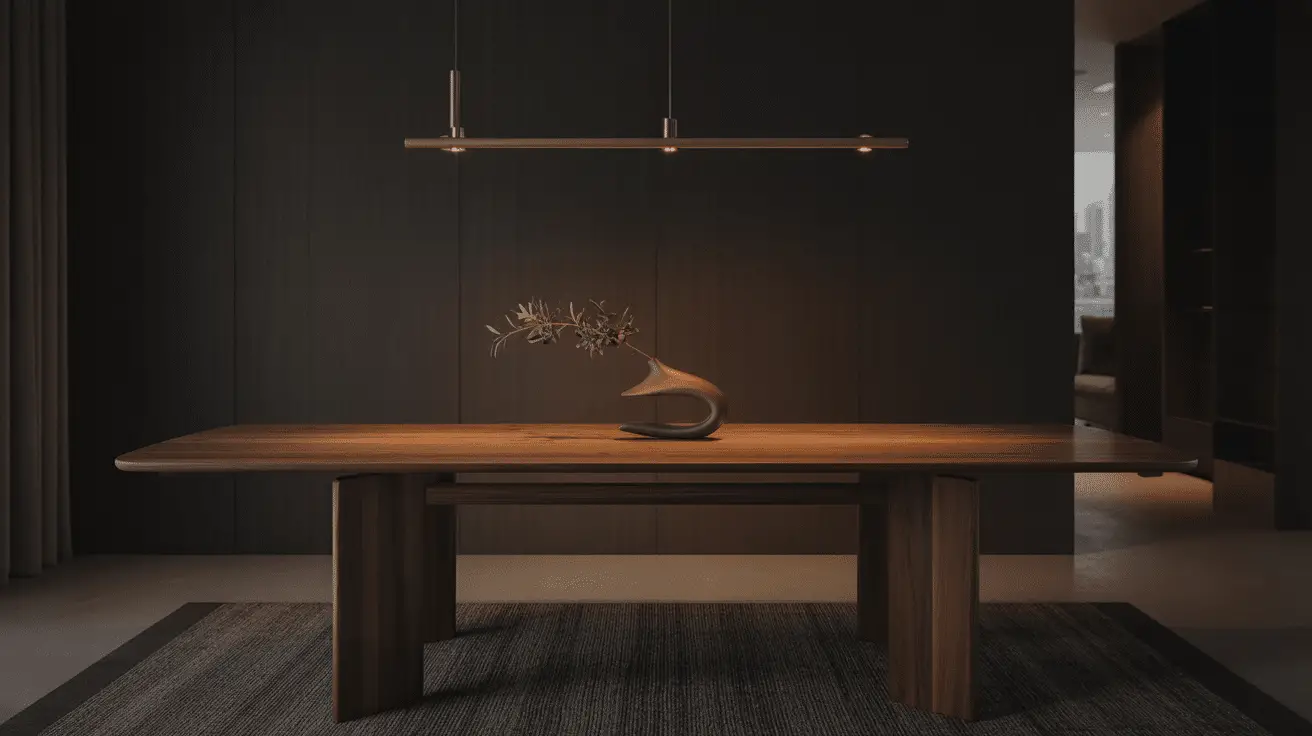Create a Minimalist Moody Dining Room with Subtle Elegance and a Dark Palette
Table of Contents
Introduction
There’s something undeniably captivating about a dark, moody dining room. The combination of minimalism and deep tones creates an atmosphere that feels intimate, sophisticated, and mysterious. More than just a trend, minimalist moody dining rooms have become a design choice for those who crave a space that feels both elevated and serene. By embracing a dark color palette with minimalist principles, you can create a dining room that exudes subtle elegance and charm, providing a refined backdrop for both everyday meals and special gatherings.
But how do you achieve this look without making the room feel oppressive or overwhelming? The secret lies in balance. A minimalist moody dining room doesn’t just rely on dark walls or furniture—it’s about creating harmony through textures, light, and thoughtfully chosen decor. It’s a design philosophy that requires restraint, an eye for detail, and a focus on quality over quantity. Whether you’re working with a small space or a larger, open area, the beauty of a dark palette is in its versatility and ability to create an atmosphere that is both calming and dramatic.
In this blog post, we will explore how to design a minimalist moody dining room that blends subtle elegance with a dark color scheme. We will cover the best colors, materials, and design techniques to create an inviting and stylish space. By the end, you’ll have a complete roadmap to turn your dining room into a modern, elegant retreat with a touch of mystery and allure.
The Power of a Dark Color Palette in a Minimalist Dining Room
Color is one of the most impactful elements in creating a minimalist moody dining room. A dark palette can be intimidating at first, but it has the power to transform a space from simple to sophisticated. When used thoughtfully, dark hues create a cozy and intimate atmosphere, perfect for a dining room.
- Deep Charcoals and Grays – These tones are a perfect starting point for a moody, minimalist dining room. Charcoal walls or gray accents add sophistication without feeling too heavy. They provide a neutral backdrop that allows other elements, such as lighting and furniture, to shine.
- Navy Blues and Inky Blacks – Navy blue or deep indigo can bring depth to a room without making it feel too dark. When paired with wood or metallic accents, these colors create an elegant, refined space.
- Earthy Browns and Greens – If you want to add warmth to the dark color palette, earthy tones like rich browns or deep olive greens can soften the overall look. These shades connect the room to nature and evoke a sense of grounding.
- Matte Finishes – Matte paint finishes are ideal for minimalist designs because they allow the walls to absorb light, creating a more subdued and calming effect. Glossy finishes can be too reflective, breaking the moody atmosphere.
The key to a successful dark color scheme is ensuring there’s enough light to keep the space from feeling cramped. Combining dark tones with natural wood elements or light fixtures can help maintain balance and prevent the room from feeling too dark or oppressive.
Balancing Light and Shadow in a Moody Dining Room
Lighting plays a pivotal role in any moody design, especially when working with a dark color palette. Without proper lighting, a dark dining room can feel too closed off, making it essential to balance shadows with strategically placed light sources. Here are a few ways to bring light into your minimalist moody dining room:
- Layered Lighting – Use a combination of ambient, task, and accent lighting to create depth. Ambient lighting, such as recessed lights or pendant lamps, can evenly illuminate the room. Task lighting, such as under-cabinet lights or sconces, helps focus light on key areas, like the dining table. Accent lighting can highlight decorative features, such as artwork or architectural elements.
- Statement Light Fixtures – Choose bold, sculptural light fixtures that draw the eye. A minimalist chandelier with clean lines or an industrial-style pendant can add a touch of elegance while providing ample light.
- Reflective Surfaces – Incorporating mirrors or glass elements into the design can reflect light around the room, creating a sense of openness without sacrificing the moody aesthetic.
- Natural Light – If your dining room has large windows or a lot of natural light, make sure to emphasize this feature. You can use dark, sheer curtains or blinds that filter the light, allowing it to gently diffuse through the room without overwhelming the space.
The right lighting will ensure that the room feels open and inviting, while maintaining the mysterious, cozy vibe that makes dark palettes so compelling.

Choosing Furniture for a Minimalist Moody Dining Room
Furniture selection is a critical component of designing a minimalist moody dining room. The goal is to keep pieces simple and elegant while ensuring they complement the dark tones of the space. Here are some furniture ideas to consider:
- Sleek Dining Tables – Look for dining tables with clean lines and minimalist designs. Opt for materials like matte wood, metal, or even stone that pair well with a moody, dark palette. A matte black or dark wood table creates a grounding focal point for the room.
- Chairs with Simple Silhouettes – Choose dining chairs with minimalistic frames and soft, muted upholstery. Look for chair designs with thin metal legs or wooden frames to keep the room feeling airy and uncluttered.
- Buffets and Sideboards – A modern, low-profile buffet or sideboard is a great addition to the space. These pieces can provide storage while maintaining a clean, minimalist aesthetic. Opt for pieces with hidden storage to keep clutter at bay.
- Textural Contrast – Mix materials for added visual interest. For example, pair a dark wooden table with velvet chairs, or a stone table with metallic accents. These contrasts add depth and complexity without overwhelming the space.
When selecting furniture, remember that less is often more. Keep the design simple, focusing on high-quality pieces that will stand the test of time. This will help ensure that your minimalist moody dining room feels refined, not overcrowded.

Incorporating Natural Materials into the Design
In a minimalist moody dining room, the right materials can elevate the space, adding warmth and texture to balance the dark palette. Natural materials, like wood, stone, and leather, introduce elements that connect the room to nature while keeping the design sleek and sophisticated.
- Wood Accents – Wood is an essential material for grounding the dark colors in the room. Dark wood finishes for the dining table, chairs, or flooring add richness without overpowering the space. For contrast, lighter wood tones can be used for shelving or small accents to add depth and warmth.
- Stone Features – Incorporating stone elements, like a stone tabletop or a marble wall, introduces natural texture and an element of luxury. These materials reflect light in a subtle way, contributing to the moody atmosphere without being too flashy.
- Leather and Fabrics – Leather dining chairs or textured fabrics in muted tones like charcoal, taupe, or deep green can add a tactile dimension to the room. These materials bring comfort and warmth while staying within the minimalist design framework.
Natural materials not only bring a sense of timeless elegance but also help soften the darkness of the color palette, creating a balanced and inviting atmosphere.
Finishing Touches: Art and Decor in a Moody Dining Room
To complete your minimalist moody dining room, carefully selected artwork and decor can elevate the space without overwhelming it. Here are some ideas for incorporating subtle, elegant touches:
- Abstract Art – Choose large-scale abstract paintings or prints in muted tones that complement the room’s color palette. Art with fluid lines or geometric shapes adds sophistication and intrigue without drawing attention away from the minimalist design.
- Sculptural Decor – Look for minimalist sculptures or vases in materials like metal, glass, or stone. These can serve as focal points on the dining table or sideboard while maintaining the room’s moody atmosphere.
- Statement Mirrors – Mirrors are perfect for reflecting light and adding a sense of space to a room. A large, sleek mirror with a simple frame can amplify the dark tones and textures in the room while also serving as a stylish decor element.
- Textile Accents – A dark-toned rug or elegant table runner can add softness and comfort to the space. Look for textiles in luxurious materials like wool, silk, or velvet for added richness.
When adding finishing touches, focus on simplicity and elegance. A few well-placed decor pieces will make your moody dining room feel complete without overwhelming the minimalist design.
Conclusion
Designing a minimalist moody dining room with a dark palette requires a careful balance of color, texture, and light. By embracing a subdued color scheme, integrating natural materials, and choosing minimalist furniture and decor, you can create a space that is both sophisticated and serene. A moody dining room doesn’t have to be dark or oppressive—it can be a warm, inviting retreat that combines subtle elegance with dramatic flair. With the right design elements, your dining room can become a beautiful, intimate space where every meal feels like a special occasion.

